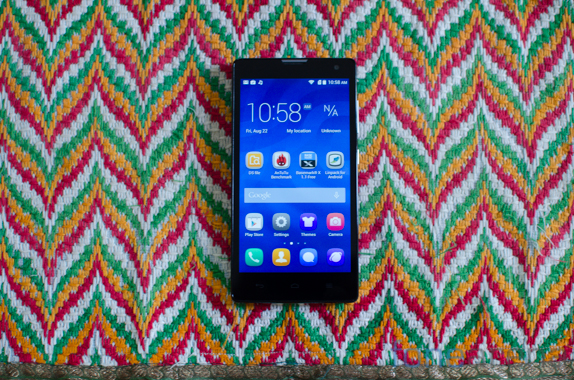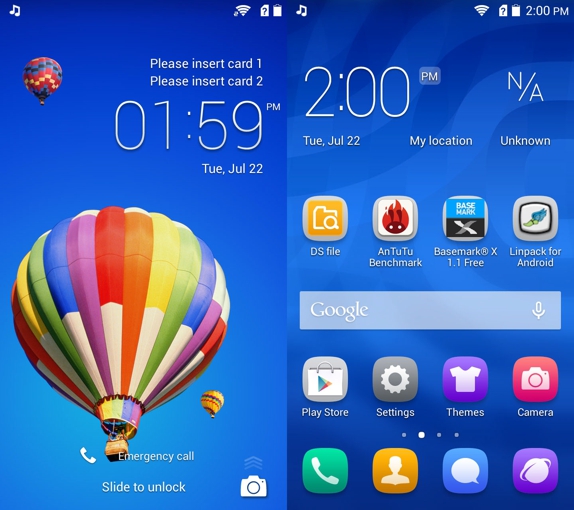
The smartphone ecosystem in India is increasingly turning out to be a hot bed of innovation with customers turning out to be the winners. With a vast variety of handsets on offer at every price point, there is a significant overlap in terms of features. What helps set things apart is to bring something unique to the table. Huawei introduced its Honor 3C in India a while back. We decided to try out the handset over an extended period of time to see how well it copes up. While not exactly their newest phone, we found it to be quite an interesting device. Read on to find out our full impressions of the smartphone.
Huawei Honor 3C Specifications
- 5-inch (1280 x 720 pixels) HD LTPS display
- 1.3GHz quad-core MediaTek MT6582 processor with Mali 400 GPU
- Dual SIM with dual standby
- Android 4.2 (Jelly Bean) with Emotion UI 2.0
- 8MP rear camera with LED Flash, Sony BSI sensor, f/2.0 aperture
- 5MP front-facing camera, 22mm wide angle lens, 1.4um large pixel sensor, F2.4 aperture
- 3.5mm audio jack
- 9.2mm thick and weighs 140 grams
- 2GB RAM, 8GB internal memory, expandable memory with MicroSD
- 3G, WiFi 802.11 b/g/n, Bluetooth, GPS
- 2300 mAh battery
Hardware
The Huawei Honor 3C is a simple yet elegant looking device. It doesn’t particularly stand out with unique design flourishes but you’ll notice that the phone feels resoundingly solid.

Up front as you’d expect is the 5inch 720p display. Below this are three capacitive buttons. Unfortunately these do not light up. Above, you’ll spot an elegantly placed earpiece grille while next to it on the right is the front facing camera module.
Placed on the right side of the device is the power button and the volume rocker. The buttons have a matte metal finish and provide excellent feedback. The left side on the other hand is completely bereft of controls. A micro USB port is placed at the bottom while the 3.5mm audio jack is placed at the top.

Continuing the elegant understated design scheme at the back, we find the Honor 3c to have a pearlescent white finish. There is no Huawei branding here and the company has opted to place a subtle Honor brand towards the top of the phone. The camera module lies flush with the handset but a small chrome ring surrounds it to keep the lens from scratching. The single LED flash is placed next to it. The speaker grille is placed near the bottom left and unfortunately the design of the handset causes this to get muffled when placed on a surface. All in all, the handset isn’t pushing any design boundaries but it brings a very solid build that could take a few bruises. 9.2mm thick, it is slim enough to fit into even your skinny jeans and the 140 grams weight, while not the lightest, will not cause discomfort even when held for long. Huawei has emphasized the 69% screen to body ratio of the handset which results in compact bezels and goes a long way in improving ergonomics.
Software
Based on Android 4.2.2, the Huawei Honor 3c runs Emotion UI 2.0 on top of the base software stack. The interface layer offers a plethora of options and in fact goes beyond most others.

The interface adopts an approach that works as a hybrid between iOS and Android. The homescreen is a rather standard affair that includes a direct shortcut to the camera. Notifications and the time and date sit proud here. Swiping to unlock the phone reveals the homescreen. There is no app drawer in the same vein as the iPhone and all apps are placed directly on the screen here. However unlike the iPhone, it is possible to place widgets directly on all the panes.

The Emotion UI 2.0 interface layer has a built in theming solution that lets you choose from a few preselected themes or customize them as you may wish. Additionally, something very unique is the presence of a ‘simple’ homescreen layout that we talk about below.

You can see the simple layout on the right with the standard interface placed on the left. The simple layout not just gives users larger touch points for applications but genuinely makes it look good. There’s a case to be made that Android shouldn’t be complex enough to require such a mode but that’s an argument for another day. A simple calendar widget is placed up top which can be swapped for the many other widgets on offer. In addition to this, the system font is also larger throughout the interface making it much easier to use for first time smartphone owners or even people who might not be too comfortable with a modern device.

The customizations extend much deeper than you’d expect in what is really a midrange handset. It is posssible to adjust the color temperature and make it warmer / cooler depending on your preference. You can also block off specific apps from accessing mobile data or WiFi as you chose.

Further, it is possible to deny certain apps from running automatically when you switch on the phone and also stop applications from sending you notifications. It goes without saying that these additions are more than welcome despite being relatively enthusiast oriented. Huawei has done a great job in ensuring that the interface does not overwhelm average users with the extended feature set while also building in enough to satisfy enthusiasts. The software not only looks good but is also very well optimized for the hardware and we never encountered any lags or slowdowns while using the phone.
Performance
The Huawei Honor 3c is powered by a 1.3Ghz quad core MediaTek MT6582 processor and is paired with 2GB of RAM of which about 1300MB is available free at launch. The phone has a Mali 400 GPU that is good enough for playing most Android games. There are occasional frame drops in graphically intensive games and the phone also has a tendency to heat up. That said, the Huawei Honor 3c performs admirably well in day to day tasks and the entire software, hardware package works well in tandem resulting in an excellent user experience. We put the phone through a slew of synthetic benchmarks to see how the phone holds up against the competition.

In the AnTuTu benchmark, the phone scores 17083 points which makes it competitive. The AnTuTu benchmark comprehensively tests core system performance.

The Huawei Honor 3c does not do too well in the Basemark X benchmark and scores just 1612 points which places it right at the bottom of our test bench.

In the GPU centric GFXBench test, the phone manages 6.5 frames per second which is about par for the course for Mediatek based handsets in this range. The Qualcomm Snapdragon based Moto G & E perform much better in comparison. Overall synthetic benchmarks tell only half the story and we’re very satisfied with performance on the Huawei Honor 3c and it never gave us reason to complain.
Camera
The Huawei Honor 3c is equipped with an 8 Megapixel rear facing camera with a Sony sensor. This is paired with an f/2.0 lens which means that the device is adequately equipped to deliver above average shots. Our experience with the phone echoed what we expected. Photos in less than ideal conditions appear a bit washed and exhibit noise but are usually better than what you’d expect from most of the competition.

Even in a moving subject like the cat above, the phone was able to get a sharp shot though the ISO levels got boosted enough to make noise a bit of an issue. Also, the white balance levels aren’t entirely accurate.
The phone does well with HDR shots as you’d expect and manages to extract details. We weren’t too impressed by the low light performance of the phone but in general, it takes more than usable images in well lit scenarios. A 5MP front facing camera is also included in the device that is well suited for the job. The phone is capable of recording Full HD videos at 30FPS.
Display
Huawei has equipped the Honor 3c with a 5 inch 720p LTPS display. The Low Temperature PolySilicon technology built into the screen allows for much faster movement of electrons. It is an active matrix LCD that is much more integrated compared to amorphous silicon substrates as it allows the deposition of thin film transistors directly on large substrates.
We found the screen to be very good in terms of contrast ratio and brightness levels with the display being viewable even in bright sunlight. The viewing angles too were very good. Huawei has built in tools to adjust color temperature which help make granular changes to the screen according to your preference.
Connectivity & Battery Life
The Huawei Honor 3c comes with dual SIM card slots and dual standby capabilities. In addition to this, it has the usual range of connectivity options including 3G, WiFi 802.11 b/g/n, Bluetooth and GPS. There’s 8GB of built in storage and this can be further bumped up by using the microSD card slot. Of the built in 8GB storage about 5.6 GB is available free at launch. There’s a 2300 mAh battery built into the phone and this proves to be perhaps the best feature of the phone. Huawei has done a fantastic job at optimizing all aspects of the hardware and this extends to the battery too. We easily got over a day of usage out of the handset with extended usage. Multiple email accounts, an hour or so of phone calls, messaging, social media, music playback and we still had about 30% battery life by the end of the day.
Conclusion
Huawei has done an admirable job with the software and hardware combination on the Honor 3c. Despite not being a very new handset, it is most certainly a formidable offering. The LTPS display, camera, software and battery life in general standout on the device.

What we’re not huge fans of was the limited built in storage and the price point. Though the Huawei Honor 3c is a very good handset, we’ve come to a point where the competition is offering even better handsets at similar price points which makes it a bit hard to recommend. That said, you really cannot go wrong with this device. Priced at just over Rs. 13,000; it stands its ground against the Asus Zenfone 5 and is a good option if you can’t get hold of the Xiaomi Mi3.
Pros
- Battery life
- Display
Cons
- Built in storage
- Low light camera performance






